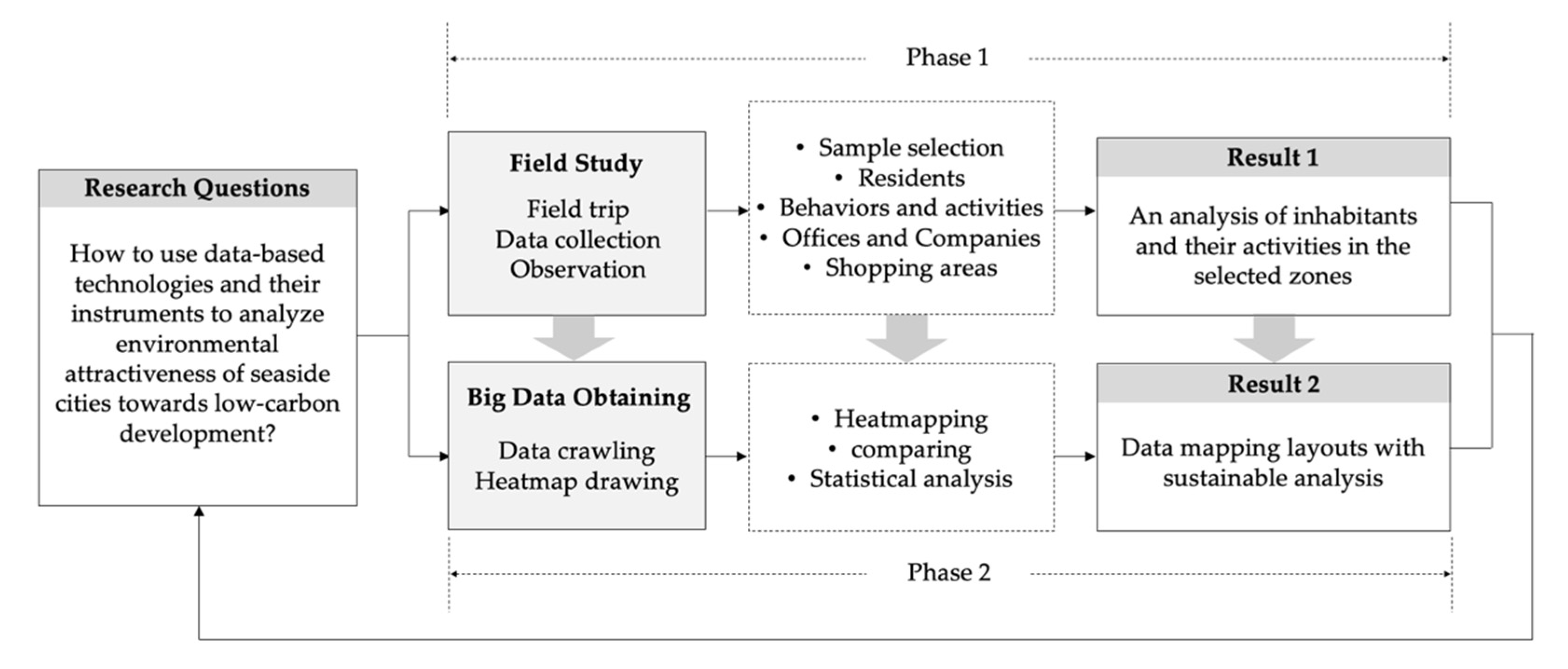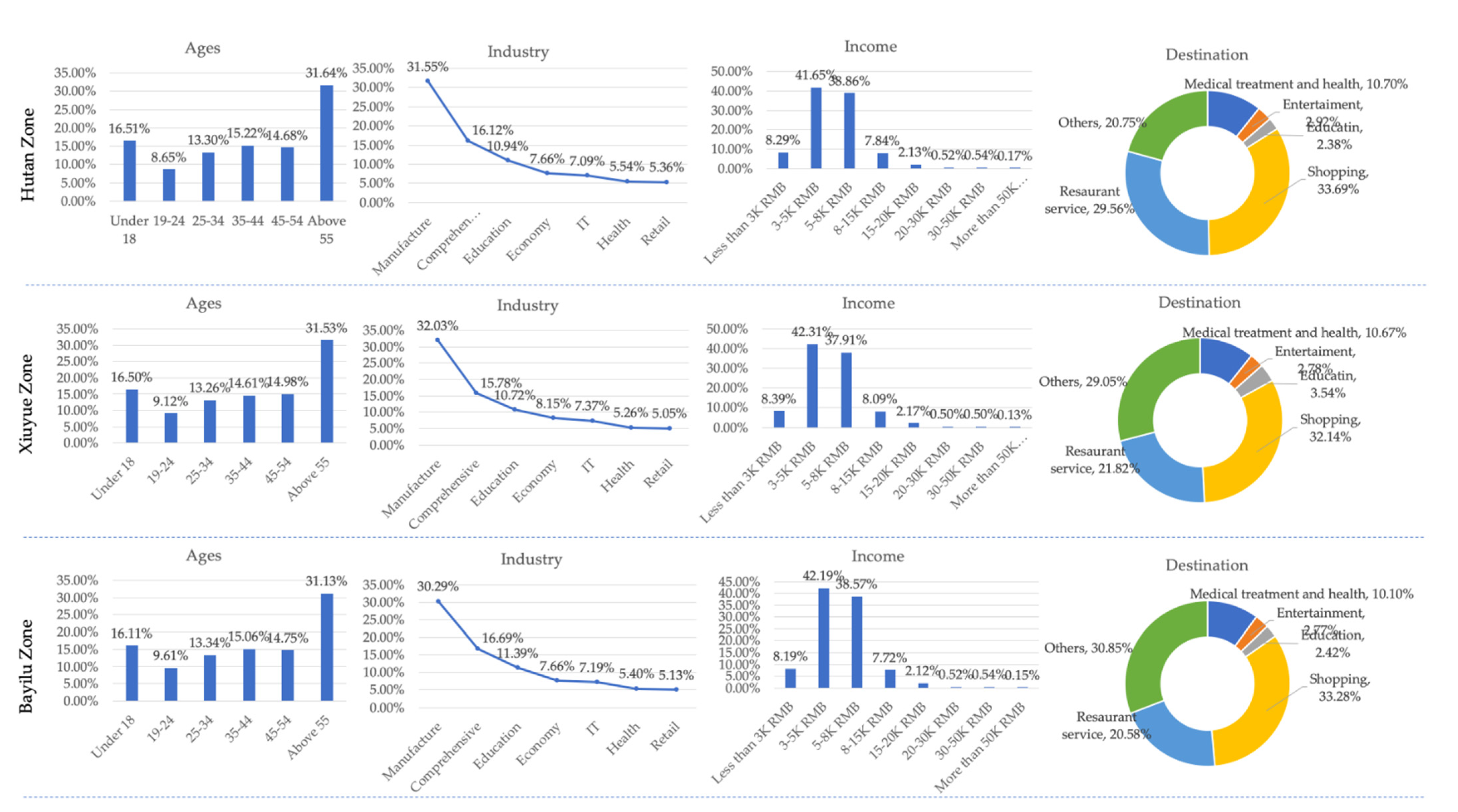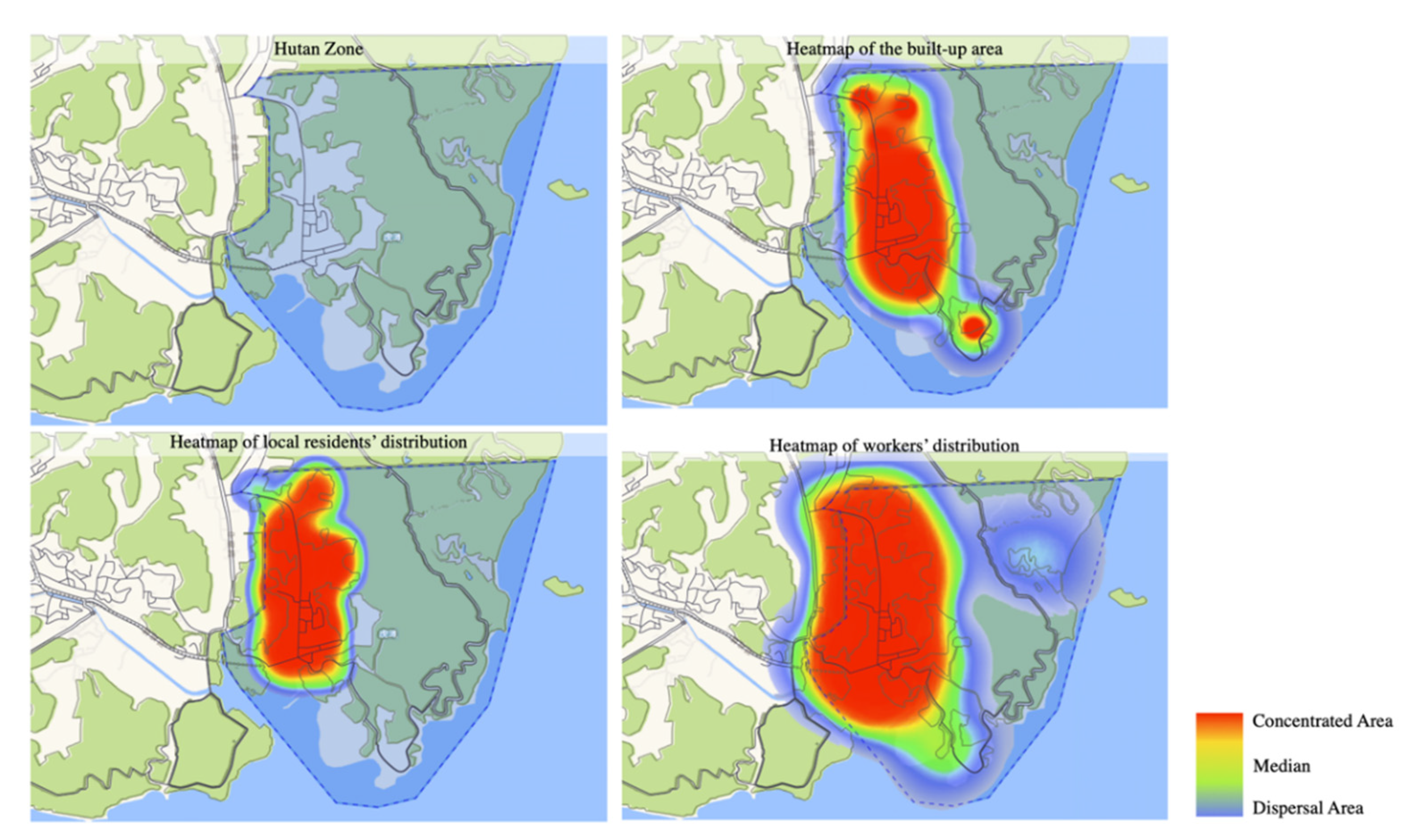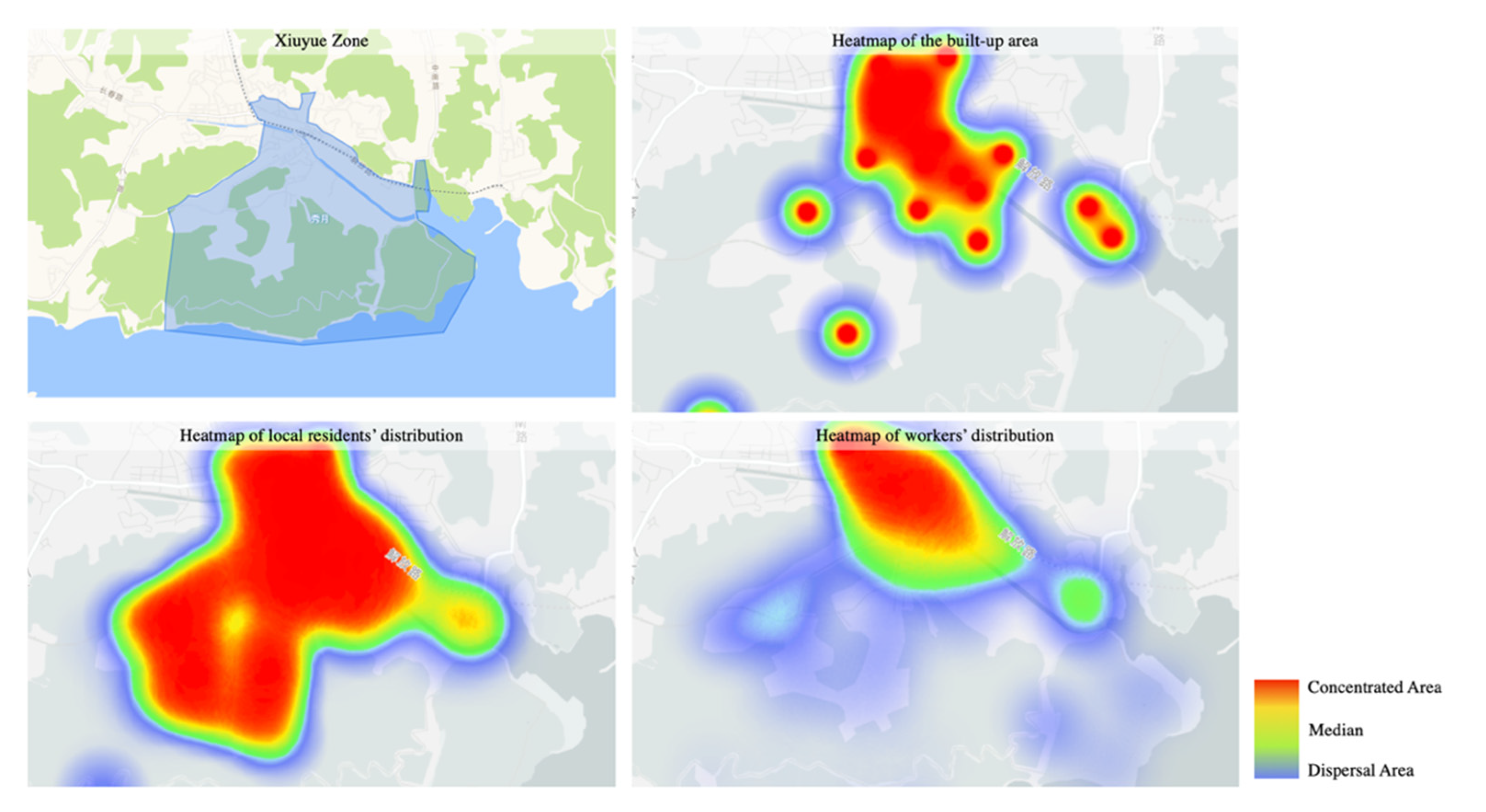Data-Based Analysis of Environmental Attractiveness towards Low-Carbon Development in Seaside Cities
Abstract
1. Introduction
2. Methods
2.1. Field Study
- Hutan Zone. It is close to a famous scenery destination called Dalian Laohutan Ocean Park. Plenty of tourists visit this area, especially in summer. That brings periodic fluctuations in the number of individuals in this zone.
- Xiuyue Zone. It is located on the west side of Hutan Zone, near the coast and adjacent to a large sea area. This zone is composed of mixed commercial and residential functions.
- Bayilu Zone. Different from the previous two zones, Bayilu is a historic zone with traces of historic buildings and places.
2.2. Big Data Obtaining
2.3. Calculating the Service Capability of Public Facilities
- G is the score of public service capability of specified area,
- Fi,j is the normalized service strength of facility I in walkable distance j,
- λ is the weight of Fi,j,
- Qi is the normalized service quality of facility i,
- μ is the weight of Qi,
- Ri is the normalized walkability of facility i,
- v is the weight of Ri,
- m is the number of facilities that could provide services, and
- n is the service distance of the facilities.
3. Results
3.1. Data Collection Results
3.2. Heatmapping Results
3.3. Calculation Results of Public Service Facilities
4. Discussion
4.1. Upgrading Industrial Structure for Low-Carbon Development
4.2. Balancing Built-Up Areas and Natural Resources for Low-Carbon Development
4.3. Principles for Planning Smart Sustainable Urban Space
5. Conclusions
Author Contributions
Funding
Data Availability Statement
Conflicts of Interest
References
- Ho, C.S.; Matsuoka, Y.; Simson, J.; Gomi, K. Low carbon urban development strategy in Malaysia—The case of Iskandar Malaysia development corridor. Habitat Int. 2013, 37, 43–51. [Google Scholar] [CrossRef]
- Graviola, G.R.; Ribeiro, M.C.; Pena, J.C. Reconciling humans and birds when designing ecological corridors and parks within urban landscapes. Ambio 2022, 51, 253–268. [Google Scholar] [CrossRef] [PubMed]
- Parry, M.L.; Canziani, O.; Palutikof, J.; Van der Linden, P.; Hanson, C. Climate Change 2007-Impacts, Adaptation and Vulnerability: Working Group II Contribution to the Fourth Assessment Report of the IPCC (Vol. 4); Cambridge University Press: Cambridge, UK, 2007. [Google Scholar]
- Satterthwaite, D. The contribution of cities to global warming and their potential contributions to solutions. Environ. Urban. ASIA 2010, 1, 1–12. [Google Scholar] [CrossRef]
- Global Health Observatory (GHO) Data. Available online: https://www.who.int/data/gho (accessed on 25 March 2022).
- Liu, Y.; Tian, W.; Zhou, X. Energy and carbon performance of urban buildings using metamodeling variable importance techniques. Build. Simul. 2021, 14, 535–547. [Google Scholar] [CrossRef]
- Joss, S.; Tomozeiu, D.; Cowley, R. Eco-Cities—A Global Survey 2011, University of Westminster International Eco-Cities Initiative; University of Westminster: London, UK, 2011. [Google Scholar]
- Metz, B.; Davidson, O.; Bosch, P.; Dave, R.; Meyer, L. Climate Change: Mitigation. Contribution of Working Group iii to the Fourth Assessment Report of the Intergovernmental Panel on Climate Change; Cambridge University Press: Cambridge, UK, 2007. [Google Scholar]
- Kongboon, R.; Gheewala, S.H.; Sampattagul, S. Greenhouse gas emissions inventory data acquisition and analytics for low carbon cities. J. Clean. Prod. 2022, 343, 130711. [Google Scholar] [CrossRef]
- Ji, A.; Liu, M. Industrial structure adjustment based on the concept of low carbon-A case of Qingdao city. Energy Procedia 2011, 5, 1621–1625. [Google Scholar]
- Bahi, E.S.M.S.; Ranjbar, E. Seeking low carbon urban design through modelling of carbon emission from different sources in urban neighborhoods, case study: Semnan. Int. J. Urban Sustain. Dev. 2021, 13, 546–568. [Google Scholar]
- Su, M.; Zheng, Y.; Yin, X.; Zhang, M.; Wei, X.; Chang, X.; Qin, Y. Practice of low-carbon city in China: The status quo and prospect. Energy Procedia 2016, 88, 44–51. [Google Scholar] [CrossRef]
- Su, M.; Chen, B.; Xing, T.; Chen, C.; Yang, Z.F. Development of low-carbon city in China: Where will it go? Procedia Environ. Sci. 2012, 13, 1143–1148. [Google Scholar] [CrossRef]
- Mirzoev, T.; Tull, K.I.; Winn, N.; Mir, G.; King, N.V.; Wright, J.M. Systematic review of the role of social inclusion within sustainable urban developments. Int. J. Sustain. Dev. World Ecol. 2022, 29, 3–17. [Google Scholar] [CrossRef]
- Liu, B.; Liu, X.; Lu, C.; Godbole, A.; Michal, G. Computational fluid dynamics simulation of carbon dioxide dispersion in a complex environment. J. Loss Prev. Process Ind. 2016, 40, 419–432. [Google Scholar] [CrossRef]
- Rodrigues, G. How Urban Planning Is Key to Net Zero: Evidence from London. Available online: https://www.centreforcities.org/blog/how-urban-planning-is-key-to-net-zero/ (accessed on 2 August 2021).
- Knapp, E.; Vandegehuchte, M.B. The tourism values of the coast: Modeling seaside amenity values in Belgium. Int. J. Hosp. Tour. Adm. 2022, 6, 1–18. [Google Scholar] [CrossRef]
- Fink, H. Human-nature for climate action: Nature-based solutions for urban sustainability. Sustainability 2016, 8, 254. [Google Scholar] [CrossRef]
- Demographic Census Data. Available online: http://www.stats.gov.cn/ztjc/zdtjgz/zgrkpc/dqcrkpc/ (accessed on 15 July 2022).
- Russo, A.; Escobedo, F.J. From smart urban forests to edible cities: New approaches in urban planning and design. Urban Plan. 2022, 7, 131–134. [Google Scholar] [CrossRef]
- China Daily: Dalian on UN List of Greenest Urban Areas. Available online: http://www.china.org.cn/english/2001/Jun/14005.htm (accessed on 22 May 2022).
- Shi, Y. China Set to Expand Targets for Marine Environmental Protection. Available online: https://www.maritime-executive.com/editorials/china-to-expand-targets-for-marine-environmental-protection (accessed on 10 May 2022).
- Yan, L. Endangered Spoonbill Birds Thrive in Dalian, Liaoning. Available online: http://www.ecns.cn/hd/2019-08-13/detail-ifzmwwnr7047278.shtml (accessed on 18 January 2022).
- Xinhua Net. Eight Spotted Seals Released into Sea in Dalian. Available online: http://www.xinhuanet.com/english/2021-04/17/c_139886029.htm (accessed on 18 January 2022).
- Dalian National Spotted Seal Nature Reserve. Available online: https://rsis.ramsar.org/ris/1147 (accessed on 12 June 2022).
- Wang, Q.; Du, Z.; Wang, B.; Chiu, Y.; Chang, T. Environmental regulation and foreign direct investment attractiveness: Evidence from China provinces. Rev. Dev. Econ. 2022, 26, 899–917. [Google Scholar] [CrossRef]
- Goldstein, I.; Spatt, C.S.; Ye, M. Big Data in Finance (Working Paper). Available online: https://ssrn.com/abstract=3809447 (accessed on 22 March 2021).
- Fan, C.; Yan, D.; Xiao, L.F.; Ao, L. Advanced data analytics for enhancing building performances: From data-driven to big data-driven approaches. Build. Simul. 2021, 14, 3–24. [Google Scholar] [CrossRef]
- Lee, A.; Lee, K.W.; Kim, K.H.; Shin, S.W. A geospatial platform to manage large-scale individual mobility for an urban digital twin platform. Remote Sens. 2022, 14, 723. [Google Scholar] [CrossRef]
- Van Dam, K.K.; Lansing, C.; Elsethagen, T.; Hathaway, J.; Guillen, Z.; Dirks, J.; Skorski, D.; Stephan, E.; Gorrissen, W.; Gorton, I.; et al. Nationwide buildings energy research enabled through an integrated data intensive. Build. Simul. 2014, 7, 335–343. [Google Scholar] [CrossRef]
- Duggal, N. Most Effective Data Collection Methods with Their Techniques and Use Cases Explained. 2021. Available online: https://www.simplilearn.com/data-collection-methods-article (accessed on 14 October 2021).
- Bhasin, H. Observation Methods—Definition, Types, Examples, Advantages. Available online: https://www.marketing91.com/observation-method/#:~:text=The%20observation%20method%20is%20described,information%20and%20data%20by%20observing (accessed on 5 March 2020).
- Fatenaite, G. Web Scraping vs. Web Crawling: The Differences. Available online: https://oxylabs.io/blog/crawling-vs-scraping (accessed on 4 May 2021).
- Sagiroglu, S.; Sinanc, D. Big data: A review. Int. Conf. Collab. Technol. Syst. 2013, 5, 42–47. [Google Scholar]
- Davenport, T.H.; Barth, P.; Bean, R. How big data is different. Sloan Manag. 2012, 54, 22–24. [Google Scholar]
- What Is Big Data. Available online: https://www.oracle.com/hk/big-data/what-is-big-data/#:~:text=The%20definition%20of%20big%20data,especially%20from%20new%20data%20sources (accessed on 8 January 2022).
- Zhang, Y.; Liu, C. Parametric Modeling for Form-Based Planning in Dense Urban Environments. Sustainability 2019, 20, 5678. [Google Scholar] [CrossRef]
- Zhang, Y.; Liu, C. Parametric Urbanism and Environment Optimization: Toward a Quality Environmental Urban Morphology. Int. J. Environ. Res. Public Health 2021, 18, 3558. [Google Scholar] [CrossRef] [PubMed]
- Pinto, G.M.; Vieira, A.P.; Neto, P.L. Parametric Urbanism as Digital Methodology: An Urban Plan in Beijing. In Proceedings of the eCAADe Regional International Workshop, Porto, Portugal, 18 September 2013. [Google Scholar]
- Gu, N.; Yu, R.; Behbahani, P.A. Parametric Design: Theoretical Development and Algorithmic Foundation for Design Generation in Architecture. In Handbook of the Mathematics of the Arts and Sciences; Springer: Cambridge, UK, 2018. [Google Scholar]
- Nagy, D. Urban Magazine: Towards a Collective Purpose; Publication of the Students of Columbia University: New York, NY, USA, 2009. [Google Scholar]
- Bell, P.A.; Baron, R.A. Environmental influences on attraction: Effects of heat, attitude similarity, and personal evaluations. Bull. Psychon. Soc. 1974, 4, 479–481. [Google Scholar] [CrossRef][Green Version]
- Likert, R. A technique for the measurement of attitudes. Arch. Psychol. 1932, 140, 1–55. [Google Scholar]
- Rouse, M.; Vaughan, J. Data Normalization. Available online: https://www.techtarget.com/searchdatamanagement/definition/normalization (accessed on 7 July 2022).
- Daniels, T.L.; Lapping, M. Land preservation: An essential ingredient in smart growth. J. Plan. Lit. 2005, 19, 316–329. [Google Scholar] [CrossRef]
- Bengston, D.N. Changing forest values and ecosystem management. Soc. Nat. Resour. 1994, 7, 515–533. [Google Scholar] [CrossRef]
- Broussard, S.R.; Washington-Ottombre, C.; Miller, B.K. Attitudes towards policies to protect open space: A comparative study of government planning officials and the general public. Landsc. Urban Plan. 2008, 86, 14–24. [Google Scholar] [CrossRef]
- Nakamura, K.; Hayashi, Y. Strategies and instruments for low-carbon urban transport: An international review on trends and effects. Transp. Policy 2013, 29, 264–274. [Google Scholar] [CrossRef]
- Yung, E.H.K.; Chan, W.H.W. Implementation challenges to the adaptive reuse of heritage buildings: Towards the goals of sustainable, low carbon cities. Habitat Int. 2012, 36, 352–361. [Google Scholar] [CrossRef]
- McGinlay, J.; Parsons, D.J.; Morris, J.; Graves, A.; Hubatova, M.; Bradbury, R.B.; Bullock, J.M. Leisure activities and social factors influence the generation of cultural ecosystem service benefits. Ecosyst. Serv. 2018, 31, 468–480. [Google Scholar] [CrossRef]






| Sample Zones | Primary Education | Medical Clinics | Sport Facilities | Cultural Facilities | Total | Weights |
|---|---|---|---|---|---|---|
| Service Intensity | ||||||
| Xiuyue Zone | 0.0 | 0.0 | 1.0 | 0.0 | 1.0 | 0.3 |
| Hutan Zone | 1 | 0.5 | 0.2 | 0.3 | 2.0 | |
| Bayilu Zone | 0.6 | 1 | 0 | 1 | 2.6 | |
| Service Quality | ||||||
| Xiuyue Zone | 0 | 1 | 0 | 0 | 1.0 | 0.4 |
| Hutan Zone | 1 | 0 | 1 | 0.9 | 2.9 | |
| Bayilu Zone | 0.6 | 0.4 | 0.4 | 1 | 2.4 | |
| Walkability | ||||||
| Xiuyue Zone | 0 | 0 | 1 | 1 | 2.0 | 0.3 |
| Hutan Zone | 0.7 | 1 | 0.2 | 0.1 | 2.0 | |
| Bayilu Zone | 1 | 0.4 | 0 | 0 | 2.4 | |
| Sample Zones | Service Intensity | Service Quality | Walkability | Score of Service Capabilities |
|---|---|---|---|---|
| Xiuyue Zone | 0.3 | 0.4 | 0.6 | 1.3 |
| Hutan Zone | 0.6 | 1.2 | 0.6 | 2.4 |
| Bayilu Zone | 0.8 | 1 | 0.4 | 2.2 |
Publisher’s Note: MDPI stays neutral with regard to jurisdictional claims in published maps and institutional affiliations. |
© 2022 by the authors. Licensee MDPI, Basel, Switzerland. This article is an open access article distributed under the terms and conditions of the Creative Commons Attribution (CC BY) license (https://creativecommons.org/licenses/by/4.0/).
Share and Cite
Zhang, Y.; Qin, M.; Lv, M.; Li, Y. Data-Based Analysis of Environmental Attractiveness towards Low-Carbon Development in Seaside Cities. Buildings 2022, 12, 2197. https://doi.org/10.3390/buildings12122197
Zhang Y, Qin M, Lv M, Li Y. Data-Based Analysis of Environmental Attractiveness towards Low-Carbon Development in Seaside Cities. Buildings. 2022; 12(12):2197. https://doi.org/10.3390/buildings12122197
Chicago/Turabian StyleZhang, Yingyi, Mengnan Qin, Meng Lv, and Yifan Li. 2022. "Data-Based Analysis of Environmental Attractiveness towards Low-Carbon Development in Seaside Cities" Buildings 12, no. 12: 2197. https://doi.org/10.3390/buildings12122197
APA StyleZhang, Y., Qin, M., Lv, M., & Li, Y. (2022). Data-Based Analysis of Environmental Attractiveness towards Low-Carbon Development in Seaside Cities. Buildings, 12(12), 2197. https://doi.org/10.3390/buildings12122197






